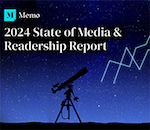 Jon Gingerich Jon Gingerich |
A series of high-profile closures in the online news-media world in recent months are eerily reminiscent of the fate that befell their print counterparts almost two decades ago. Despite massive audiences and unmatched influence, the formerly bearish digital news industry that disrupted traditional publishing in the aughts and established media empires in the twenty-tens is now in the midst of a major upheaval.
The New York Times on May 1 reported that Vice Media Group is preparing to file for bankruptcy. The youth-focused media brand, which was valued at $5.7 billion five years ago and is one of the largest independent media companies in the world, is searching for a buyer after reportedly falling $100 million short of its 2022 revenue projections. The company, which includes a suite of traditional, broadcast and digital media properties, allegedly turned down a $3.5 billion acquisition deal from Disney in 2016.
Vice isn’t alone, of course. Huffington Post parent Buzzfeed surprised everyone in April when it announced it was shuttering its widely popular news division, BuzzFeed News—which won a Pulitzer and shuttled a brand previously known for listicles into journalistic legitimacy—amid plans to reduce its workforce by 15 percent due to economic challenges. Vox Media, publisher of popular news sites Vox and The Verge—as well as New York magazine—announced in January it was laying off almost 10 percent of its staff. Then there was Gawker. The infamous gossip blog, which was relaunched in 2021 by Bustle Digital Group after its original incarnation was sued into oblivion in 2016 by Hulk Hogan, folded in February, less than two years after it was revived. The reason? BDG was “reluctantly” forced to lay off eight percent of its workforce after a disastrous first quarter.
While 2022 saw the beginning of a rocky financial period for social media companies, it’s becoming clear that 2023 has similarly foretold hard times for the digital news world. Granted, some online outlets have always had trouble monetizing content—Salon has famously never made a profit in its entire 28-year history—but others have been financial behemoths, have earned the adoration of the youth market and seemingly get all the traffic in the world. So, why are so many of our most popular digital brands going bust?
The big reason, of course, is advertising. Companies still recovering from the pandemic have tightened their belts on ad spending in response to an uncertain economy, a declining stock market, rising inflation and increasing interest rates. As ad revenues plummet, the business model that kept the lights on at newsrooms has gone dark. Even digital firebrands like TikTok have downgraded their ad outlook.
Our current economic climate has forced budget constraints onto consumers as well, resulting in fewer people paying for digital subscriptions or access to premium content. While the digital-media consumption boom that began during the pandemic continues in the U.S. as well as worldwide, an annual forecast released in April by PQ Media shows that consumers—now facing higher prices on everything from food to rent—have begun to cut discretionary spending on expenditures such as media subscription services.
Another problem is the domino effect these online outlets have felt from the economic fallout that’s hit big tech. Tech companies have been laying off employees in droves this year, and much of the venture capital cash that funded these outlets has dried up. A March Muck Rack study found that a lack of funding now accounts for journalists’ top worry, and two-thirds now say their work has been affected by economic uncertainty.
Social media’s waning influence on digital publishing is arguably even a bigger deal than the larger tech recession. The news industry has always had a bone to pick with sites like Facebook for relying on the content created by newsrooms while sharing none of the ad revenue those clicks generate. But let’s face it: these news sites get the lion’s share of their traffic from links posted to social platforms—and publishers know it. Facebook stopped promoting news content last year in a bid to tamp down on the amount of misinformation being spread over its platform, and it hit publishers hard. Also, take into account the fact that audiences in recent years have fled sites like Twitter and Facebook for less newsy social options such as Instagram and TikTok, so it’s gotten harder for news organizations to reach as many people as they did before. Now that social media platforms are getting out of the news business, digital news organizations are feeling the inevitable pinch.
I’m going to suggest that the end of our social media era of news isn’t necessarily a bad thing. Election cycles have proven that misinformation often trends higher than actual news, which means fake news can be monetized more easily than facts. Worse, it can also have more influence. And because gossip, mindless clickbait and reactive outrage copy get the most clicks on social media, these sites contour their output to meet that demand. Which means we get more garbage content and the quality of our news suffers immeasurably. Now, with the advent of generative AI in newsrooms, you can expect information in the chatbot age to get even worse—if you can imagine that. Maybe it’s time for a restart.


 Trump Media & Technology Group today reported a $58.2M net loss on $4.1M in 2023 revenues, a disclosure that drove its stock price down 22.6 percent to $47.96.
Trump Media & Technology Group today reported a $58.2M net loss on $4.1M in 2023 revenues, a disclosure that drove its stock price down 22.6 percent to $47.96. Barry Pollack, an attorney at Wall Street’s Harris St. Laurent & Wechsler, has registered Julian Assange as a client with the Justice Dept. “out of an abundance of caution.”
Barry Pollack, an attorney at Wall Street’s Harris St. Laurent & Wechsler, has registered Julian Assange as a client with the Justice Dept. “out of an abundance of caution.” Paramount Global to slash 800 jobs in what chief executive Bob Bakish calls part of an effort to “return the company to earnings growth"... Rolling Stone editor-in-chief Noah Shachtman is exiting at the end of the month due to disagreements with chief executive Gus Wenner over the direction the magazine is taking... The New York Times broke the $1 billion barrier in annual revenue from digital subscriptions in 2023... Press Forward is investing more than $500 million to strengthen local newsrooms.
Paramount Global to slash 800 jobs in what chief executive Bob Bakish calls part of an effort to “return the company to earnings growth"... Rolling Stone editor-in-chief Noah Shachtman is exiting at the end of the month due to disagreements with chief executive Gus Wenner over the direction the magazine is taking... The New York Times broke the $1 billion barrier in annual revenue from digital subscriptions in 2023... Press Forward is investing more than $500 million to strengthen local newsrooms. The majority of news articles are read within the first three days of publication, according to a recent report.
The majority of news articles are read within the first three days of publication, according to a recent report. The Los Angeles Times gives pink slips to 115 people or 20 percent of its newsroom staff... TIME is also laying off about 30 employees, which is approximately 15 percent of its editorial staff... The Baltimore Banner, which was launched by Stewart Bainum in 2022 after he failed to buy the Baltimore Sun, added 500 subscribers per day in the three days following Sinclair Broadcast Group's deal to purchase the Sun.
The Los Angeles Times gives pink slips to 115 people or 20 percent of its newsroom staff... TIME is also laying off about 30 employees, which is approximately 15 percent of its editorial staff... The Baltimore Banner, which was launched by Stewart Bainum in 2022 after he failed to buy the Baltimore Sun, added 500 subscribers per day in the three days following Sinclair Broadcast Group's deal to purchase the Sun.


 Have a comment? Send it to
Have a comment? Send it to 
No comments have been submitted for this story yet.